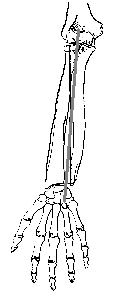Elbow and Radio-ulnar Joints
Structure: both joints are uniaxial:
Muscles
Synergies among muscles that cross the elbow, radioulnar, or glenohumeral joints
The elbow in American literature
Elbow and radio-ulnar arthrokinematics
applying the rules of concavity and convexity to the humero-ulnar joint:
- in an open chain,
concave ulnar surface rolls and glides in same direction on convex humeral surface.
- in a closed chain,
the convex humeral surface rolls and glides in
opposite directions on the concave ulnar surface.
during open chain elbow extension:
ulna rolls and glides posteriorly on humerus
while
- radius moves distally
- ulna and radius spread apart
- ulna and radius pronate with respect to
each other.
during open chain elbow flexion:
ulna rolls and glides anteriorly on humerus
while
- radius moves proximally
- ulna and radius move closer together
- ulna and radius supinate with respect to
each other.
Radio-ulnar joint axis

| The radio-ulnar joint's axis is an oblique line that connects the superior and inferior radio-ulnar joints.
Around this axis,the radio-ulnar joints pronates and supinates.
|
|---|
Muscles that cross the elbow can produce flexion or extension:
muscles whose attachments are very close
to the elbow joint's lateral axis
produce no meaningful elbow movement
- on lat epicondyle:
- extensor digitorum
- extensor carpi ulnaris
- extensor carpi radialis brevis
- on med epicondyle:
- flexor digitorum superficialis
- flexor carpi ulnaris
muscles that flex the elbow joint:
- from attachments superior to the lateral epicondyle:
- extensor carpi radialis longus
one of your texts (Smith, Weiss, & Lehmkuhl, 1996, p. 163) states that extensor carpi radialis brevis (ECRB) also flexes the elbow. This statement is difficult to defend because ECRB's proximal attachment is on the epicondyle, very close the elbow's axis.
- from attachments on the medial epicondyle:
- pronator teres
- flexor carpi radialis
- palmaris longus
- from other sites of attachment:
- biceps
- brachialis
- brachioradialis
Muscles that extend the elbow joint:
Muscles that cross the radio-ulnar joint can produce pronation or supination:
muscles of the anterior forearm (pronators)
- pronator quadratus
- pronator teres
- flexor carpi radialis
muscles of the posterior forearm (supinators)
- supinator
- biceps
- (extensor pollicis longus)
- (extensor indicis)
Four examples of synergies that involve multi-articular upper extremity muscles
- biceps brachii is a multi-articular muscle that:
- flexes the elbow
- supinates the radio-ulnar joint
for biceps brachii to supinate the radioulnar joint
without flexing the elbow,
it must act in synergy with an elbow extensor.
for biceps to flex the elbow without supinating the r-u joint,
it must act in synergy with a r-u pronator.
- the humeral head of pronator teres:
- pronates the radioulnar joint
- flexes the elbow
for pronator teres (humeral head)
to pronate the radioulnar joint
without flexing the elbow,
it must act in synergy with an elbow extensor.
long head of biceps brachii
- attaches to superior aspect of glenoid fossa.
- crosses anteriorly to glenohumeral joint's
lateral axis,
- flexes the gh joint unless it acts in synergy with a gh extensor.
- synergy prevents overshortening and loss of
force production in biceps brachii.
- long head of triceps brachii
- attaches to inferior aspect of glenoid fossa.
- crosses posteriorly to glenohumeral joint's
lateral axis,
- extends gh joint unless it acts in synergy with a gh flexor.
- synergy prevents overshortening and loss of
force production in triceps brachii.

